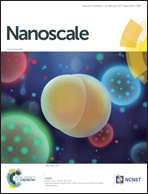Contrast mechanisms on nanoscale subsurface imaging in ultrasonic AFM: scattering of ultrasonic waves and contact stiffness of the tip–sample†
Abstract
Ultrasonic atomic force microscopy (AFM) and its associated derivatives are nondestructive techniques that can elucidate subsurface nanoscale structures and properties. Despite the usefulness of these techniques, the physical contrast mechanisms responsible for the reported subsurface features observed in ultrasonic AFM are not well defined. In this study, we present a comprehensive model combining ultrasonic wave scattering and tip–sample contact stiffness to better reproduce the experimentally measured phase variations over subsurface features in two model systems. These model systems represent the two extreme sample types typically imaged by ultrasonic AFM, one being a hard material and the other a soft polymeric material. The theoretical analysis presented and associated comparisons with experimental results suggest that the image contrast depends on the combination of two contrast mechanisms: the perturbation of the scattered ultrasonic waves and the local variation of the contact stiffness at the tip–sample contact. The results of this study open up a new door for the depth estimation of buried nanoscale features into hard (engineering structures) and soft (polymers and biological structures) materials, and eventually lead to non-invasive, high-resolution 3D nano-tomography by ultrasonic AFM.



 Please wait while we load your content...
Please wait while we load your content...